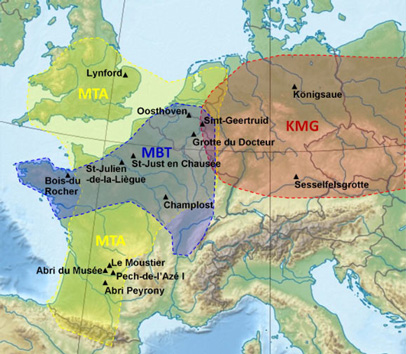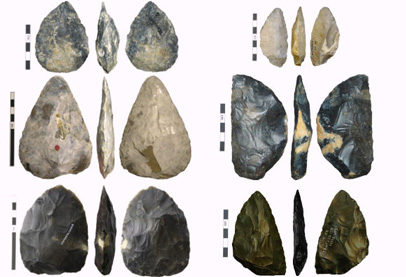New Study of Neanderthal Hand Axes Suggests Two European Neanderthal Cultures
Design of Hand Axes Reveals Distinctive Neanderthal Cultures
A study by a postgraduate researcher at the University of Southampton has found that Neanderthals were more culturally complex than previously acknowledged. Two cultural traditions existed among Neanderthals living in what is now northern Europe between 115,000 to 35,000 years ago. Dr Karen Ruebens from the Centre for the Archaeology of Human Origins (CAHO) and funded by the Arts and Humanities Research Council examined the design of 1,300 stone tools originating from eighty Neanderthal sites in five European countries; France, Germany, Belgium, Britain and the Netherlands.
Neanderthal Study
Her investigations uncovered new evidence that two separate hand axe traditions or designs existed – one in a region now spanning south-western France and Britain – the other in Germany and further to the East. In addition, she found an area covering modern day Belgium and the Netherlands that demonstrates a transition between the two. Two separate hand axe traditions or designs that have been identified by this analysis are, firstly the Mousterian of Acheulean Tradition (MTA on the map below), in a region now spanning south-western France and Britain and the Keilmessergruppen Tradition (KMG on the map below), in Germany and further to the East.
Evidence for Regionality in Neanderthal Cultures
Picture credit: Dr Karen Ruebens
Different Neanderthal Cultures
The map above marks the approximate boundaries of the different cultures with a transitional zone which features Mousterian with Bifacial tools (marked MBT) between the two distinct tool making cultures. Please note, the English Channel did not exist during the time of the Neanderthals. Low sea levels at this time in Earth’s history permitted the United Kingdom to remain part of the European mainland, the UK did not become an island until about 8,000 years ago.
Dr Ruebens commented:
“In Germany and France there appears to be two separate hand axe traditions, with clear boundaries, indicating completely separate, independent developments. The transition zone in Belgium and Northern France indicates contact between the different groups of Neanderthals, which is generally difficult to identify but has been much talked about, especially in relation to later contacts with groups of modern humans. This area can be seen as a melting pot of ideas where mobile groups of Neanderthals, both from the eastern and western tradition, would pass by – influencing each other’s designs and leaving behind a more varied record of bifacial tools.”
Neanderthal Hand Axes
The University of Southampton research has revealed Neanderthals in the western region made symmetrical, triangular and heart-shaped hand axes, while during the same time period, in the eastern region, they produced asymmetrically shaped bifacial knives.
This research has been published shortly after another paper shed further light on the culture of Neanderthals. A study of Neanderthal bone tools found in France and published in the Proceedings of the National Academy of Sciences (USA) suggested that Neanderthals developed specialised tools for working animal skins many thousands of years before such tools became associated with our own species.
To read more about this research: Neanderthals Made the First Specialised Bone Tools in Europe.
Dr Ruebens went onto add:
“Distinct ways of making a hand axe were passed on from generation to generation and for long enough to become visible in the archaeological record. This indicates a strong mechanism of social learning within these two groups and says something about the stability and connectivity of the Neanderthal populations. Making stone tools was not merely an opportunistic task. A lot of time, effort and tradition were invested and these tools carry a certain amount of socio-cultural information, which does not contribute directly to their function.”
The study’s extensive analysis also shows other factors which could have influenced hand axe design, such as raw material availability to Neanderthals, the function of their sites, or the repeated reuse and sharpening of tools – did not have an impact in this instance. This research provides a new perspective on the regionality of the Neanderthal population of western Europe.
Examples of the Different Types of Hand Axe
Picture credit: Dr Karen Ruebens
Key to the hand axes in the picture above:
Left: Mousterian of Acheulean Tradition hand axes, from top to bottom – cordiform hand axe from Le Moustier, France; triangular hand axe from St. Just en Chaussée, France; hand axe from Lynford, UK (Karen Ruebens). Right: Keilmessergruppen Tradition hand axes, from top to bottom – keilmesser from Sesselfesgrotte, Germany; keilmesser from Abri du Musée, France; faustkeilblatt from Königsaue, Germany.
Intriguingly, this study suggests that those Neanderthals that went on to live in Britain, have closer affinities to those Neanderthals from south-western France than they do to Neanderthal populations from Germany, central and western France as well as central Europe.
Everything Dinosaur acknowledges the help of the University of Southampton in the compilation of this article.



